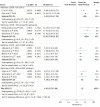Association Between Fluid Balance and Outcomes in Critically Ill Children: A Systematic Review and Meta-analysis
- PMID: 29356810
- PMCID: PMC5885847
- DOI: 10.1001/jamapediatrics.2017.4540
Association Between Fluid Balance and Outcomes in Critically Ill Children: A Systematic Review and Meta-analysis
Abstract
Importance: After initial resuscitation, critically ill children may accumulate fluid and develop fluid overload. Accruing evidence suggests that fluid overload contributes to greater complexity of care and worse outcomes.
Objective: To describe the methods to measure fluid balance, define fluid overload, and evaluate the association between fluid balance and outcomes in critically ill children.
Data sources: Systematic search of MEDLINE, EMBASE, Cochrane Library, trial registries, and selected gray literature from inception to March 2017.
Study selection: Studies of children admitted to pediatric intensive care units that described fluid balance or fluid overload and reported outcomes of interest were included. No language restrictions were applied.
Data extraction and synthesis: All stages were conducted independently by 2 reviewers. Data extracted included study characteristics, population, fluid metrics, and outcomes. Risk of bias was assessed using the Newcastle-Ottawa Scale. Narrative description of fluid assessment methods and fluid overload definitions was done. When feasible, pooled analyses were performed using random-effects models.
Main outcomes and measures: Mortality was the primary outcome. Secondary outcomes included treatment intensity, organ failure, and resource use.
Results: A total of 44 studies (7507 children) were included in this systematic review and meta-analysis. Of those, 27 (61%) were retrospective cohort studies, 13 (30%) were prospective cohort studies, 3 (7%) were case-control studies, and 1 study (2%) was a secondary analysis of a randomized trial. The proportion of children with fluid overload varied by case mix and fluid overload definition (median, 33%; range, 10%-83%). Fluid overload, however defined, was associated with increased in-hospital mortality (17 studies [n = 2853]; odds ratio [OR], 4.34 [95% CI, 3.01-6.26]; I2 = 61%). Survivors had lower percentage fluid overload than nonsurvivors (22 studies [n = 2848]; mean difference, -5.62 [95% CI, -7.28 to -3.97]; I2 = 76%). After adjustment for illness severity, there was a 6% increase in odds of mortality for every 1% increase in percentage fluid overload (11 studies [n = 3200]; adjusted OR, 1.06 [95% CI, 1.03-1.10]; I2 = 66%). Fluid overload was associated with increased risk for prolonged mechanical ventilation (>48 hours) (3 studies [n = 631]; OR, 2.14 [95% CI, 1.25-3.66]; I2 = 0%) and acute kidney injury (7 studies [n = 1833]; OR, 2.36 [95% CI, 1.27-4.38]; I2 = 78%).
Conclusions and relevance: Fluid overload is common and is associated with substantial morbidity and mortality in critically ill children. Additional research should now ideally focus on interventions aimed to mitigate the potential for harm associated with fluid overload.
Conflict of interest statement
Figures



Comment in
-
Fluid overload in critically ill children is associated with increased mortality.J Pediatr. 2018 Jul;198:322-325. doi: 10.1016/j.jpeds.2018.04.059. J Pediatr. 2018. PMID: 29936964 No abstract available.
-
In critically ill children, fluid overload is consistently associated with worse outcomes.BMJ Evid Based Med. 2019 Feb;24(1):41-42. doi: 10.1136/bmjebm-2018-111009. Epub 2018 Jul 31. BMJ Evid Based Med. 2019. PMID: 30065112 No abstract available.
References
-
- Rhodes A, Evans LE, Alhazzani W, et al. . Surviving Sepsis Campaign: international guidelines for management of sepsis and septic shock: 2016. Crit Care Med. 2017;45(3):486-552. - PubMed
-
- Davis AL, Carcillo JA, Aneja RK, et al. . American College of Critical Care Medicine clinical practice parameters for hemodynamic support of pediatric and neonatal septic shock. Crit Care Med. 2017;45(6):1061-1093. - PubMed
-
- Bhaskar P, Dhar AV, Thompson M, Quigley R, Modem V. Early fluid accumulation in children with shock and ICU mortality: a matched case-control study. Intensive Care Med. 2015;41(8):1445-1453. - PubMed
Publication types
MeSH terms
LinkOut - more resources
Full Text Sources
Other Literature Sources
Medical

